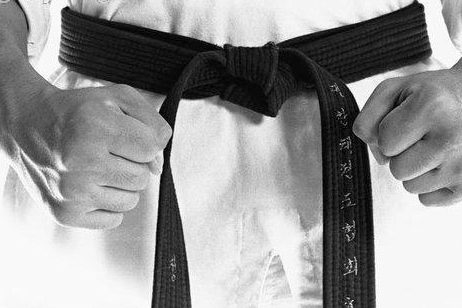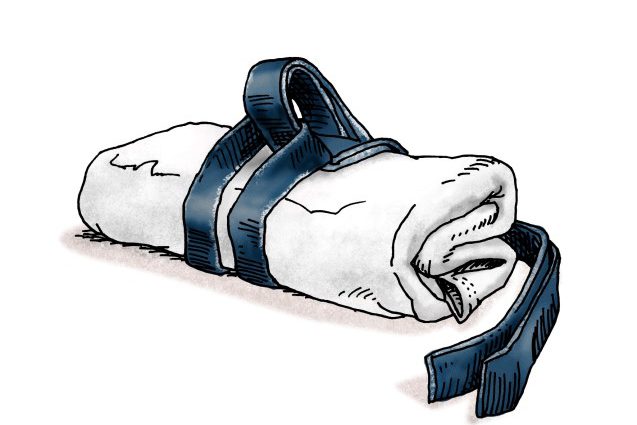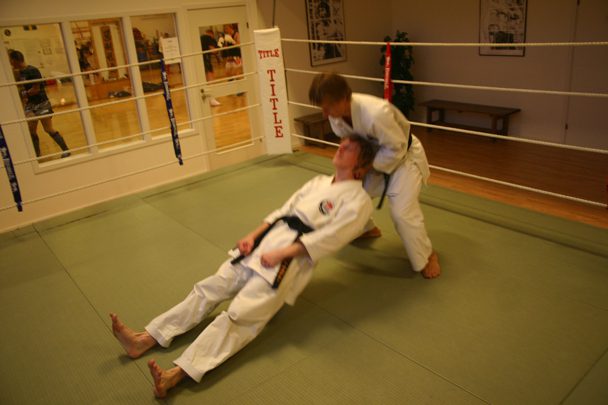Two weeks ago I received an e-mail that sent shivers down my spine.
Read it yourself (slightly edited):
Hey Jesse!
I’ve been following your blog for a little while now.
I have been studying a karate system for some time and feel that they are not only a Mcdojo but also a cult. ie. using methods from military type cults. I’m not joking either.
Although I love training in karate I’m at a loss as to what I should do now. Of course the school will call me weak and put me down to the other students etc for not continuing but what am I to do? I love martial arts but feel I am selling myself out if I stick with this system.
Surely people who continue with cult like groups are truly weak.
You must have had some experience with this type of thing in the past? I’d value your opinion.
Thanks for your time,
A-san
Whoah…
At first, when I received this letter, I wasn’t sure if somebody was tricking me or if it was for real. I mean, c’mon, how many people one day wake up and discover that what they’ve been doing for years is not what they were after in the first place?
Not that many.
A-san, I applaud your efforts and will with this very post try my best to help you, and anybody else who is stuck in a McDojo cult, leave. However, in writing this, I realize this post is not for everybody.
Changing requires guts.
It’s not so much that we’re afraid of change, or so in love with the old ways, but… it’s that place in between that many of us fear. We aren’t comfortable there, because there’s nothing to hold on to.
Recognize yourself?
Well, you’d better hold on to this post, because here we go:
“Nobody can go back and start a new beginning, but anyone can start today and make a new ending.”
The 5 golden steps for leaving your McDojo cult:
Step #1: Identify
First of all, you need to ask yourself if you really are trapped in a “McDojo cult”. This is a tricky question, because, just like a fish who doesn’t notice the water around it, if you are truly nestled in a McDojo you are hardly going to realize it.
Unless you have the rare courage and ability to see things for what they are.
So, to help you identify a McDojo cult, let’s break it down a little:
There are approximately 31’000 McDonald’s restaurants globally. Antarctica is the only continent that does not have a McDonald’s restaurant – yet. McDonald’s has sold well over 100 billion hamburgers world-wide, and the CEO of McDonald’s made $17 million last year.
To most people, that would qualify as successfull.
However, quality can be measured in many ways.
Let’s look at the product. What does McDonald’s sell?
Hamburgers.
Take the word “hamburger”. A hamburger refers to a model, of sorts. It has a recognizable hamburger “essence” whether it’s on sliced sourdough bread or the buns you can buy. It has a distinguishable look. Anybody recognizes a hamburger.
Sure, for some, ketchup is required. Like one day, in New Zealand, when a friend of mine had to pay extra for it. He didn’t, on general principle, and ate the burger dry.
It sucked.
So, even though they can vary somewhat on the inside (ketchup or not, chicken, grilled, etc…), a hamburger is still a hamburger. “But hey, wait a minute”, someone might say. “My mom makes the best hamburgers in the world! It’s different!”
Yeah, sure, just like each school’s Karate, they’re all different in one way or other… UNLESS you are getting them from McDonald’s, a corporation that takes great effort in, and prides itself on, the consistency of its product. At a McDonalds, you always get the same.
But if one were after the perfect hamburger… McDonald’s is not the place to go.
Is it?
If I were to create hamburgers for my family and friends, I would not try to replicate the McDonald’s product. I’m sure you wouldn’t either. Instead, I would strive for the ideal expression of the essence that is a hamburger (I seriously hope you’re catching my numerous Karate references throughout this text, by the way). I would probably bake the buns myself. I would also drive some miles – past a number of grocery stores and McDonalds’ – to a particular butcher shop, where I know the meat will be of superior quality.
I would also start a fire under my grill, because the best hamburgers are always grilled over a fire (Burger King got that one right).
Skipping ahead… My family and friends each like their hamburger a bit differently: The cheese will be available, mayonnaise, pickles, lettuce, onions (both raw and cooked), sliced tomatoes, a variety of sauces… and I’ll let each build his/her own hamburger, because you know what – we are all different and there is no major corporation or organization here to stuff a “hamburger” down our throats at the moment.
When each hamburger is plated, it is unique; yet all fall under the general classification of “hamburger.”
However, comparing our own hamburgers to a McDonalds is like comparing night to day.
So, from the above we can draw some general conclusions that will help you determine (identify) if your dojo is truly a McDojo:
-
1.1: A McDojo cult prefers perfect duplication of a general form/pattern (kata) over individual expression.
A true Karate practitioner always strives to seek a better expression of the essence of Karate. So, when performing a kata, I don’t want to repeat and copy a thing dumbly because… well… that will only last for so long. Now, don’t get me wrong, I’m not saying repetition and copying is wrong (it is sometimes VERY right) but there is dumb and smart repetition.
The aim of a kata is to approach an ideal.
A Utopia.
As long as your efforts are toward that ideal, the kata will never be wrong… horseradish and hot peppers or not. That is to say, it might look different from your buddy’s kata, and that’s all right. As long as it doesn’t stray from the true path.
Not in a McDojo though.
Consistency, absolute correctness in form and obediance (often disguised as respect or tradition) are of utmost importance, to ensure proper McDojo “quality”.
In a McDojo there is always only one way. To be interested in what others are doing is “wrong”, because if you look around you might actually discover the truth.
And your sensei thinks you can’t handle the truth.
-
1.2: The McDojo head chef (sensei) is God – but might sometimes fake humbleness to appear human.
Genius is rare.
Not every sensei in the historical course of Karate or Kobudo was a Leonardo da Vinci or Beethoven (in the martial arts sense), and the chances of  your sensei being one is infinitely small.
your sensei being one is infinitely small.
Sure, I’m one, but I’m also extraordinarily handsome and unexplainably attractive. Oh, did I mention I’m also unbelievably humble?
Let’s make that moderately attractive then.
Jokes aside though, some sensei are just better with the people and politics. Some are better with marketing and promotion. While some are experts at history, physical training, sports psychology or philosophy.
Conversely, if your sensei claims, or acts, like he/she is an authority in all of the fields above, ignoring the fact that the new yellow belt in the club might have a Bachelor of Arts in Design and is much better suited for designing the new club poster, you are quite possibly under the wings of a bona-fide McDojo owner.
A McDojo chef is the be-all and end-all.
Oh, and in terms of lineage (which is very important in McDojo’s), connections like Socrates >Plato >Aristotle are extraordinary, and certainly not expected. Take caution. Even though a great lineage certainly gives a feeling of genuinity and tradition, it’s never a guarantee of anything.
Oh, and in a McDojo reference is frequently made to Okinawa, Japan or deceased old masters and their glorious ways. Why? Because not many people know how to check the truth of those facts (being culturally different and all).
So they blindly swallow.
-
1.3: A McDojo prefers Quantity over Quality. Loudly.
Completely ignoring the practical application of things like Hick’s law, The Gricean Maxims of Quality and Quantity and Deliberate Practise (intropection being at its core), a McDojo cult will have you learn a new thing before you even knew you had learnt the old thing.
The trick here is, of course, to overwhelm you with so many new techniques and moves that you  feel bad about yourself. That you feel like you suck and need to train more, much more. And you feel like your sensei is great, much greater than you, since he knows so many things.
feel bad about yourself. That you feel like you suck and need to train more, much more. And you feel like your sensei is great, much greater than you, since he knows so many things.
This is something they pride themselves in.
Choice. Freedom. Individuality.
Our menu is wider and taller than the McDojo next door, which means we are better. We have two hundred more techniques, practise fifty extra secret joint locks, and learn thirty more weapons.
We give you what you can’t get anywhere else.
Add $5, and you get and extra-plus-menu-super-size diploma.
-
1.4: A McDojo makes you either feel bad or feel nothing.
When you first enter a McDojo you’re overjoyed. So much to choose from! So great credentials! Such a joyous atmosphere!

However, after the initial ecstasy fades away, everytime you leave class (after a McDojo training session), you feel either:
a) bad (about yourself) or…
b) nothing.
I don’t know what you prefer, but when I leave training I like to feel glad and satisfied – for many reasons:
Glad that I always did my best and that I learnt a couple of new details I had forgotten, happy that I never gave up, satisfied with being part of a class where everyone loves to help out and improve, and anticipated to see what the future holds in store for me in my journey.
I feel fresh and new.
In a McDojo you feel like shit though.
Or you feel nothing.
Kind of like after having eaten at a McDonald’s restaurant – you either feel hungry again… or full of shit.
But you never admit it.
Because that’s not what cult members do.
-
1.5: A McDojo forces you to do stuff that is “voluntary”
“Ahh, ummm… hey, kiddo, can you come and clean the dojo next week? Your sensei, I, needs to attend an important Grand Master meeting with the World McDojo Sokeship Council next week and it would be truly respectful of you to come and clean the dojo from top to bottom. Actually, you can begin right now.”
“Hai, sensei!”
Sorry, I forgot, what’s Japanese for sucker?

Sure, being in a dojo means you have duties. That’s a given. But those duties should never stretch further than happily teaching less advanced students (often for free), just like somebody taught you when you were a clueless beginner. It’s the circle of life and all, you know? That’s what makes this art live on.
Teaching is one thing.
Polishing your McSensei’s shiny bald head with one hand, while mopping the floor with you other hand, and stirring him a drink with your third (?) hand is a completely other thing, unless you actually choose to do these things. If not, then that’s not Karate, that’s abuse.
And clearly you can’t say no.
Because saying “no” implies that you know better than your sensei. Oh, do you now? You might as well go start your own dojo then, right? And give yourself a brand spankin’ new diploma, along with a shiny red and gold belt. And buy a fancy title too. I mean, it’s not like anybody else has done that, right?… RIGHT?… oh, wait… shoot, they have!
They’re called McSenseis.
And they eat kind people like you.
They often make fun of you too, when you’re not around. Kind of like bullies, actually. But more subtle. Now go swab the floor and paint the walls, or you’ll never get your next belt. “Show some good ol’ goddamn Okinawan traditional Karate respect for God’s sake, boy!”
I have to admit though, I myself volunteered in Okinawa once to clean up a park.
I couldn’t stand the old grannies and grandpas doing it alone.
Learn to differentiate.
These were only a few pointers for identifying a McDojo “cult”. Basically every McDojo will have the above points to some degree (more or less) and there are other telltale signs too (like having to learn an abundance of these strange Japanese words), but this should be enough for now. Remember that McDojos exist everywhere in the world, even in Japan. Your physical/geographical location doesn’t matter.
Another important aspect of the identification process, by the way, is questioning.
Ask questions, and carefully observe the answers.
The truth shall set you free.
Step #2, #3, #4, #5: Get out of there!
Seriously?
You really need 5 steps?
If you thought there were actually 5 steps for leaving a McDojo cult, you’re seriously mistaken. I only wrote that because it looks good in the header. There’s only 2. Or more, if you make it more. But please don’t.
Identify it (1), and if “yes”, leave it (2).
Cold turkey. Just go. Simple as that.
I mean, you could probably try to talk to them, and tell them that “peeps, we need to change” but it is highly unlikely that they’ll do anything about it (except label you a lunatic). And if you do actually convert some of the members into non-believers (“guys, there’s REAL hamburgers over there, follow me!”) it will come as a rude shock to the rest of them, and they might even turn violent on you.
So, just leave.
And never look back.
Oh, and what about your friends?
Don’t care about what your peers will say. People who make fun of you right now are just people who will respect you later. If you want to leave, do it right now. They can only mock you in their spare time. You, on the other hand, have to live with yourself all the time.
A tree will never bloom, no matter how tall it is, if its roots are rotten.
And until they realize this, you’ll simply have to leave on your own, A-san.
Good luck.
We believe in you.




18 Comments